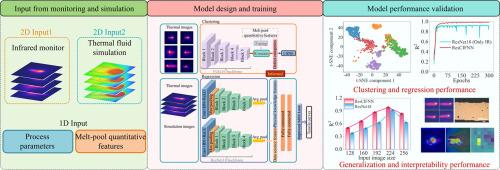A monitoring framework for predicting laser directed energy deposition property
IF 9.4
1区 工程技术
Q1 ENGINEERING, MECHANICAL
International Journal of Mechanical Sciences
Pub Date : 2025-09-18
DOI:10.1016/j.ijmecsci.2025.110861
引用次数: 0
Abstract
In Laser directed energy deposition (LDED) additive manufacturing, challenges such as porosity, surface defects, cracks, and the complex relationship between melt pool dynamics and mechanical properties still impede consistent quality control. Traditional monitoring and prediction remain fragmented and signal-specific, limiting early defect discovery and degrading reliability in safety-critical parts. To tackle these limitations, this study introduces a novel data-driven framework integrating multi-level feature fusion and dual-task learning, which significantly improves LDED process monitoring and prediction. This work proposes ResCIFNN, a ResNet-based framework that couples unsupervised, defect-aware clustering with supervised regression under a sliding time-window, enabling defect-informed prediction of tensile behavior. Utilizing melt pool infrared images, simulation data, and quantitative features, ResCIFNN achieves a precise mapping of melt pool dynamics to mechanical properties. Five-fold validation shows robust clustering (Silhouette = 0.7588; DBI = 0.3480). For tensile property prediction, ResCIFNN delivers an RMSE of 0.1113 and R² of 0.9875, surpassing ResNet18 (RMSE = 0.2821, R² = 0.9207) by reducing RMSE by 60.5 % and improving R² by 0.0668. Robustness tests under noise/occlusion yield RMSE ≤ 0.2011; Grad-CAM highlights high-temperature cores and edges, reinforcing interpretability. This pioneering approach not only elevates defect classification and mechanical property prediction but also provides a scalable, interpretable solution for quality assurance, with broad potential for additive manufacturing.

预测激光定向能沉积性能的监测框架
在激光定向能沉积(LDED)增材制造中,诸如孔隙度、表面缺陷、裂纹以及熔池动力学和力学性能之间的复杂关系等挑战仍然阻碍着质量控制的一致性。传统的监测和预测仍然是碎片化和信号特异性的,限制了早期缺陷的发现,降低了安全关键部件的可靠性。为了解决这些限制,本研究引入了一种新的数据驱动框架,该框架集成了多层次特征融合和双任务学习,显著提高了lcd过程的监测和预测。这项工作提出了ResCIFNN,这是一个基于resnet的框架,将无监督的、缺陷感知的聚类与滑动时间窗口下的监督回归结合在一起,实现了缺陷知情的拉伸行为预测。利用熔池红外图像、模拟数据和定量特征,ResCIFNN实现了熔池动力学到机械性能的精确映射。五重验证显示了稳健的聚类(剪影= 0.7588;DBI = 0.3480)。对于拉伸性能预测,ResCIFNN的RMSE为0.1113,R²为0.9875,超过ResNet18 (RMSE = 0.2821, R²= 0.9207),RMSE降低了60.5%,R²提高了0.0668。噪声/遮挡产率RMSE≤0.2011的稳健性检验;Grad-CAM突出高温核心和边缘,加强可解释性。这种开创性的方法不仅提高了缺陷分类和机械性能预测,而且为质量保证提供了可扩展、可解释的解决方案,具有广泛的增材制造潜力。
本文章由计算机程序翻译,如有差异,请以英文原文为准。
求助全文
约1分钟内获得全文
求助全文
来源期刊

International Journal of Mechanical Sciences
工程技术-工程:机械
CiteScore
12.80
自引率
17.80%
发文量
769
审稿时长
19 days
期刊介绍:
The International Journal of Mechanical Sciences (IJMS) serves as a global platform for the publication and dissemination of original research that contributes to a deeper scientific understanding of the fundamental disciplines within mechanical, civil, and material engineering.
The primary focus of IJMS is to showcase innovative and ground-breaking work that utilizes analytical and computational modeling techniques, such as Finite Element Method (FEM), Boundary Element Method (BEM), and mesh-free methods, among others. These modeling methods are applied to diverse fields including rigid-body mechanics (e.g., dynamics, vibration, stability), structural mechanics, metal forming, advanced materials (e.g., metals, composites, cellular, smart) behavior and applications, impact mechanics, strain localization, and other nonlinear effects (e.g., large deflections, plasticity, fracture).
Additionally, IJMS covers the realms of fluid mechanics (both external and internal flows), tribology, thermodynamics, and materials processing. These subjects collectively form the core of the journal's content.
In summary, IJMS provides a prestigious platform for researchers to present their original contributions, shedding light on analytical and computational modeling methods in various areas of mechanical engineering, as well as exploring the behavior and application of advanced materials, fluid mechanics, thermodynamics, and materials processing.
 求助内容:
求助内容: 应助结果提醒方式:
应助结果提醒方式:


